Oradour-sur-Glane

Notes from my trip to see the ruins
of the village
On June 10, 2004 I read a newspaper article
that had been posted on one of the newsgroups on the Internet.
It told about Vincent Reynouard, a 33-year-old former math teacher
in France, who had been sentenced on June 9th to two years in
prison for making a documentary film which claimed that the innocent
victims of the massacre in the peaceful village of Oradour-sur-Glane
had been killed because they were connected with the French
Resistance. Reynouard, who is also the author of a revisionist
book about the tragedy at Oradour-sur-Glane, had previously been
banned from practicing his profession after he was found to be
a Holocaust denier. The story of his sentencing had been timed
to coincide with the anniversary date of the Oradour-sur-Glane
massacre, 60 years ago.
With all the news coverage about the
60th anniversary of the D-day invasion of Europe on June 6, 2004,
the story of Reynouard's sentencing was printed by newspapers
around the world. The article that I read had been copied from
the Internet web site of a newspaper in Scotland.
 Vincent Reynouard
Vincent Reynouard
By June 14th, I had dusted off my camera,
booked a flight to France, reserved a hotel room in Oradour-sur-Glane,
and was spending many hours doing research on the subject. I
wanted to understand why someone would have the audacity to insult
the memory of the dead in such an insensitive manner, which is
not only bad form, it is also against the law in France. Reynouard didn't just make a
film, he sent copies of his documentary to the only two remaining
survivors of the massacre, according to the news reports. As
part of his sentence, he was ordered to pay a fine with some
of the money going to one of the survivors whom he had grossly
offended with his revisionist film.
At the end of September, I flew to Strasbourg,
the capital of the French province of Alsace. I stayed in Strasbourg
for one night, then took a train to the city of Obernai. From
Obernai, I took a taxi to the nearby Nazi concentration camp
at Natzweiler-Struthof
where captured French Resistance fighters were imprisoned. At
the camp, a new Museum, in honor of the French Resistance which
helped to liberate Europe from the Nazis 60 years ago, was under
construction.
Then I took the train back to Strasbourg
and flew to Limoges, the nearest city to Oradour-sur-Glane. I
had to change planes in Paris since there was no direct flight.
As it turned out, the Limoges airport is between the city and
the village ruins, so I took a taxi directly from the airport
to my hotel, without ever entering Limoges. There were rental
cars available at the airport but I decided that I didn't need
a car.
From the Limoges airport, my taxi driver
drove south on road N141 which was clearly marked with signs
pointing to Oradour-sur-Glane. Then he turned off on road D9
which goes past the southern entrance to the ruined village.
My first sight of the old village was from the highway. I immediately
recognized the old church which is on a small hill, only a short
distance from the former southern entrance to the village which
is now closed off by a locked iron gate. From the highway, you
cannot tell that the church is only an empty shell with no roof.
The church steeple is gone, but the church looks better without
it, in my opinion.
Near the entrance to the new town, D9
turns sharply to the left but the street into the new town of
Oradour-sur-Glane goes straight ahead, passing the new church,
set upon a low hill on the left. The new church is a modern building
that is reminiscent of the old church. It has a tower with no
steeple just like the ruined church. We drove one block past
the church to the Hotel de Glane which faces the town square.
It has a red awning over the entrance which easily identifies
it.
In the photo below the street on the
right of the church is named Tenth of June (in French, of course).
This photo was taken from the road. On the other side of the
road, to the right, but out of camera range, is the ruins of
the old village.
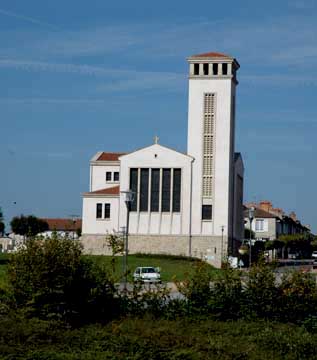
The photo below shows the other side
of the church, which faces the village. This is the front of
the church. There are three entrance doors, one in the center
which opens into the nave of the church and one on each side
which open into the side altars. Like the old church in the ruins,
it is built on a hill with a retaining wall along side of it.
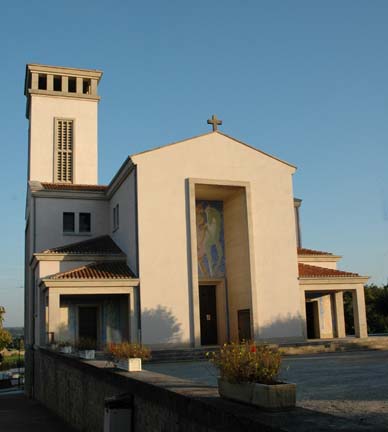
The new town, which now has 2,000 residents,
was built only a stone's throw from the ruins of the old village,
The first stone for the new town was laid on 10 June 1947, exactly
three years after the old village was destroyed. It was deliberately
designed to look as austere as possible, with all the buildings
painted gray with white shutters. While it was being built, the
survivors of the old village were housed in temporary barracks
buildings. The new town opened in 1953, but it took several years
before it was fully occupied. Factories were built to encourage
new residents to move there.
The photo below shows a typical house
in the new town. On the extreme right is the Hotel Milord which
has a very nice restaurant. Notice that the house is built right
next to the sidewalk, just like the houses in the old village.
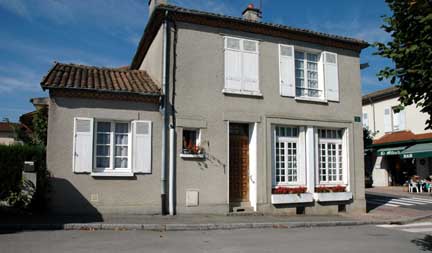
The Hotel de Glane, where I stayed, is
the best hotel in town, but I was surprised to learn that the
staff didn't speak either English or German. The hotel is conveniently
located on the town square, only a block from the Center of Memory
which is the only entrance to the ruined village. Another building
on the town square looks like a public building, but the sign
on it says "Hotel de Ville." There was a Hotel de Ville
on the town square in Obernai, so I deduced that this must be
a French hotel chain. However, there were no signs of life in
this building, and since it was a weekend, this building might
be just what it looks like - the town hall.
The Hotel de Glane has only 10 rooms,
and it was full to capacity while I was there. Reservations can
be made online and it is very inexpensive. The photo below shows
the hotel on the right; next to it is a restaurant which serves
inexpensive meals.
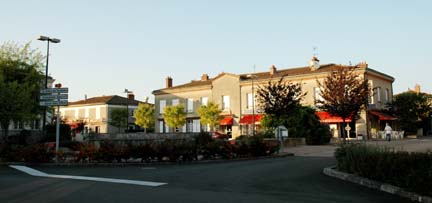
My hotel room faced the town square which
was lit up at night. I couldn't figure out how to lower the wooden
blinds outside the window, so I spent a sleepless night in a
room that was bathed in light. The next day I brought a staff
member up to my room and since she couldn't speak a word of English,
I had to communicate with her by hand gestures. That night, it
turned cold and I discovered that the steam radiator in the room
did not provide any heat, but thankfully, there was an extra
blanket in the closet. The room also had no air conditioning
and only one electrical outlet. I had to unplug the TV set to
use the battery charger for my digital camera.
Breakfast was not served at the hotel
until 8 a.m. and a nearby bakery wasn't open until 7 a.m. Apparently,
a full breakfast is not popular in France, where the continental
breakfast of coffee and a croissant is the norm. I am usually
up at first light and out with my camera, so I like to have a
big breakfast very early in the morning. This was not possible
at any of the hotels where I stayed in France.
My hotel room reservation had specified
that one free breakfast was included. However, when I checked
out, I noticed that I had been charged for two breakfasts and
the one breakfast that I ate at the hotel had not been free.
The hotel has no lift or elevator, so I had to struggle to get
my suitcases up and down the stairs with no help.
On my last day in Oradour-sur-Glane,
I went to the nearby bakery for breakfast at 7 a.m. All the customers
were older men, of an age that they would have been children
in 1944. The proprietor shook hands with all of them as they
entered. After breakfast, I asked the proprietor to call a taxi
for me to get back to the airport. I had allowed plenty of time
because I thought the taxi might be coming all the way from Limoges,
but to my surprise, the taxi arrived as soon as the man in the
bakery put down the phone.
The nearby Hotel Milord, which has 8
rooms, seems to be associated with the Hotel de Glane, since
staff members work in both locations. I ate most of my meals
at the Hotel Milord, which serves excellent food. There was a
Hotel Milord in the old village, which had such a good reputation
for fine dining that people would come from Paris to eat there.
The present Hotel Milord seems to be carrying on this tradition.
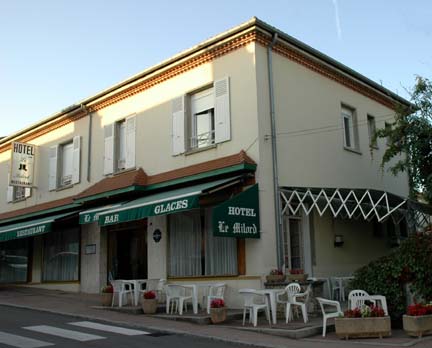
The photo above shows the Hotel Milord
in the new town. Dinner is served at 7 p.m., lunch at 12 noon
and breakfast at 8 a.m. During the day, drinks are available
on the patio.
Restaurants in France do not have red
or orange walls and they do not play loud music to encourage
the patrons to eat quickly and get out. Lunch guests are expected
to stay at least an hour and a half to finish their three-course
meal. One thing that I found to be very disconcerting was that
several of the French restaurants where I lunched had flies because
the front door was left open. The Hotel Milord had the door closed
and there were no flies circling over the tables. Normally, I
don't eat desert, but the deserts at the Milord were to die for.
I had planned to take photos in France,
using film as well as a digital camera. When I got to my local
airport to begin my journey, I observed a large sign outside
which warned against putting film into checked luggage because
it would be damaged by x-rays.
I knew that the film in my carry-on bag
would have to go through several x-ray machines because of my
planned flight from Strasbourg to Limoges and back. Each time,
it would be necessary to change planes in Paris, so altogether
my film would have to be x-rayed at least 12 times. In actuality,
it was more than 12 times, since in France, it is required to
put your carry-on luggage through x-ray machines at more than
one location in the airport before getting on the plane.
In the past, I have had no problem with
handing my film to the person at the x-ray machine and asking
them to put it through without x-raying it. I got past the first
two x-ray machines in America without any difficulty. It was
only when I got to the gate to board the plane from Paris to
Strasbourg that I encountered a problem. The attendants at the
x-ray machine spoke only a few words of English and they adamantly
refused to let me hand my film through to avoid having it x-rayed.
I finally decided to just give up the idea of using film. Thank
God for digital cameras!
In Oradour-sur-Glane, the post office
is conveniently located right next to the Hotel de Glane. It
would have been possible to use film and mail the exposed film
back to my home, but I had already decided to use only my digital
camera. There is a store conveniently located near the hotel
where one can buy film, but at what cost, I don't know.
Getting money from a cash machine is
no problem in Oradour-sur-Glane. There is an ATM machine right
next to the Post Office, and another machine only half a block
away. By using a bank debit card, I got a better exchange rate,
although I had to pay a fee to my bank for using another bank's
machine. Credit cards were accepted at the hotel and the restaurants
in town, as well as at the bookstore in the Center of Memory.
|